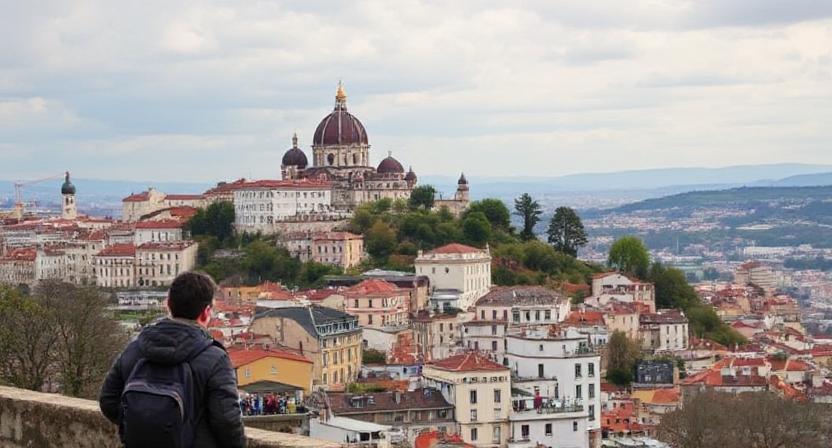Home » TOURISM NEWS » France’s Montmartre Faces New Overtourism Challenges as Rising Visitor Numbers Impact Local Life and Heritage
Published on
August 24, 2025
Montmartre, which was a thriving bohemian village of France and artists’ haven in the heart of Paris, is slowly being overwhelmed by the pressures of overtourism. Although the neighborhood is still one of the most visited tourist spots in Paris, the constant stream of tourists has started eroding the same things that made it stand out in the first place. Center of the protests lies the Sacré-Cœur Basilica, which hosts between 11 million visitors every year—more than the Eiffel Tower.
The Growing Pressure of Overcrowding and the Loss of Local Life
In response to the tourism explosion, protest banners now adorn the balconies of homes, stating messages like, “Behind the postcard: locals mistreated by the mayor.” Another banner, written in French, boldly declares: “Montmartre residents resisting.” These banners speak to the broader frustration felt by local businesses and residents who are seeing traditional shops like butchers, bakers, and greengrocers replaced by bubble tea stands, souvenir shops, and ice cream vendors catering to the growing tourist market.
This shift towards tourist-centric businesses is contributing to what many are calling the “Disneyfication” of Montmartre. The neighborhood, once known for its authentic Parisian charm, is now dominated by mass-produced experiences that focus more on tourism consumption than local culture. Residents worry that this transformation could lead to Montmartre becoming a “hollow” neighborhood, catering more to tourists than the people who have called it home for generations.
The Negative Aspects of Over-Tourism: The Economic and Cultural Costs
While tourism brings economic benefits, overtourism often leads to negative consequences for local communities. One of the main issues is the loss of authenticity, as neighborhoods become overrun with businesses catering only to tourists rather than meeting the needs of residents. Long-time local shops and markets that once defined Montmartre are disappearing, replaced by retailers selling trinkets and items that bear little relation to the culture and traditions of the area.
The shift towards tourist-driven commerce in France means that local families and workers are increasingly unable to afford to live in the area, pushing out the authentic character of the neighborhood. Rent prices rise as luxury tourism takes precedence, further pricing out locals who have lived in Montmartre for decades.
In addition to economic displacement, the sheer volume of tourists is causing overcrowding, particularly during peak tourist seasons. This increases pollution, waste, and noise, negatively impacting the quality of life for people living in the area. These factors contribute to the growing resentment of residents who feel they are no longer part of the fabric of their own neighborhood.
Social Media and the Impact of Tourism on Local Identity
While tourists flock to Montmartre to capture the perfect photo for social media, many locals feel that the area has become more about creating content for platforms like Instagram than about experiencing the authentic culture of Paris. The emphasis on “Instagrammable” moments often undermines the historical significance and local traditions that made Montmartre unique in the first place.
Social media influencers and tourists sharing their experiences of the Sacré-Cœur Basilica, cobblestone streets, and the Moulin Rouge create an environment where Montmartre becomes reduced to a backdrop for viral photos rather than a living, breathing neighborhood. The constant flow of content from tourists and social media influencers contributes to the commodification of Montmartre, creating an artificial narrative of what the area represents and obscuring its rich cultural heritage.
Solutions to Combat Over-Tourism: Can Montmartre Be Saved?
Urban planners and tourism experts warn that if overtourism continues unchecked, Montmartre could fall victim to the growing phenomenon of “zombie cities”—places that have lost their local identity and charm, becoming little more than a tourist attraction. To preserve the integrity of Montmartre and similar neighborhoods, experts suggest adopting sustainable tourism practices that prioritize the well-being of local communities alongside tourism growth.
Some potential solutions include:
- Limiting Visitor Numbers: To prevent overcrowding and protect cultural landmarks, establishing a visitor cap for Montmartre could help maintain its authenticity.
- Diversifying Tourism: Encouraging tourists to explore other parts of Paris and France could reduce the strain on popular spots and help distribute tourism more evenly across the city.
- Supporting Local Businesses: Initiatives to protect local shops and traditional markets could ensure that Montmartre remains a vibrant community rather than a commercialized tourist zone.
- Increasing Visitor Education: Educating tourists on the historical and cultural significance of Montmartre could foster greater respect for the local way of life and encourage more responsible behavior.
Finding a Balance Between Tourism and Local Life in France
Montmartre’s constant struggle with overtourism is a warning for cities everywhere that are dealing with the same issues. As visitor numbers keep increasing, Montmartre—and other old neighborhoods—need to find a balance between bringing in international visitors and maintaining the local culture that defines it. By embracing policies of sustainable tourism, promoting community participation, and safeguarding local heritage, Paris can guarantee that Montmartre remains a dynamic, real-life element of the city for locals and tourists alike.
